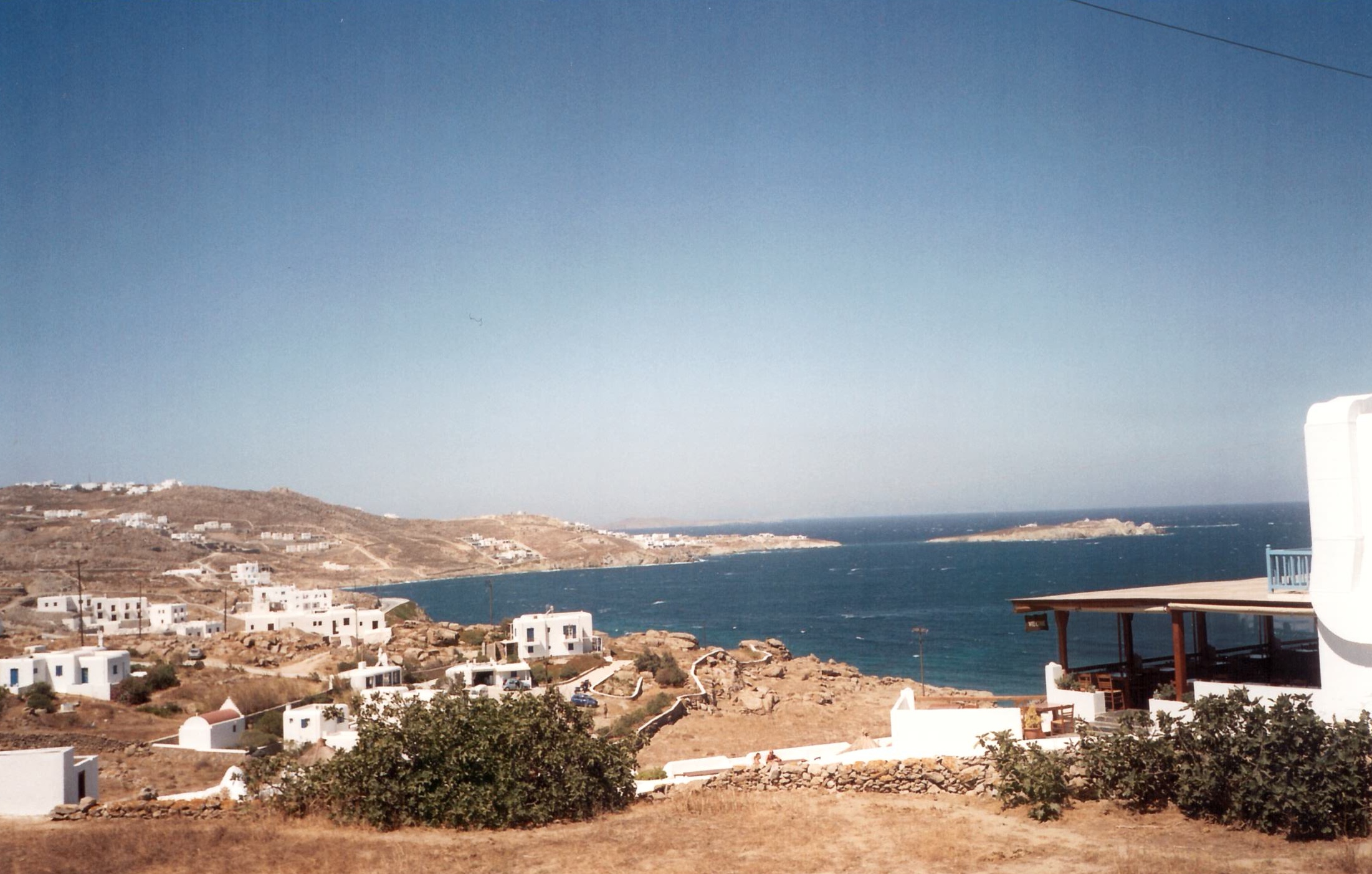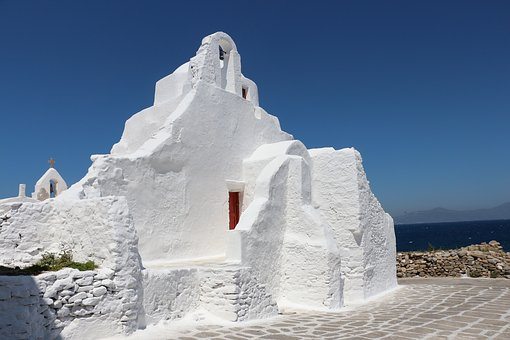3 – 17 agosto 2005
Ero rimasta così piacevolmente sorpresa e catturata dal fascino dell’isola di Santorini, che tre anni dopo ho deciso di “tuffarmi “ (solo idealmente però, dato che non so nuotare!) nuovamente nel Mar Egeo ed esplorare un’altra isola tra le più conosciute dell’arcipelago delle Cicladi: Mykonos.
3 – 17 August 2005
I had been so surprised and amazed by Santorini that, three years later I decided to “dive” (only virtually, because I can’t swim!) into the Aegean Sea again and explore another one of the most popular islands of the Cyclades: Mykonos.
I motivi per cui essa è famosa sono principalmente la sua vita notturna scatenata, e la trasgressione e stravaganza dei turisti che la invadono in estate… in realtà, accanto a questi aspetti, ce ne sono altri per i quali vale la pena visitarla. Mykonos presenta infatti i tipici paesaggi, i colori e l’architettura degli edifici delle isole Cicladi ed è per questo altrettanto pittoresca quanto Santorini.
It is mainly known for its wild night life and the outrageous, eccentric tourists who crowd it in the summer… actually, other reasons make it worth visiting. Mykonos has the typical landscape, colours and architectural features of the Cyclades and it is therefore as picturesque as Santorini.
Il paesaggio e le spiagge
Ho trascorso due settimane in un villaggio turistico nella località di Kalafatis sulla costa orientale dell’isola. Il paesaggio è quello tipico di queste isole: poca vegetazione, il colore marrone del terreno arido, le case bianche sparse qua e là, ed il blu intenso del mare.
Landscape and beaches
I spent two weeks in a holiday village in Kalafatis on the east coast of the island. The landscape is typical of these islands: little vegetation, the brown color of the arid land, the white houses scattered here and there, and the intense blue of the sea.
La spiaggia vicino a cui sorgeva il villaggio era ampia e lunga, fatta di ghiaino bianco e sul fondale marino vi erano anche sassi piuttosto grandi; il mare era cristallino, le sue acque erano di un colore verde azzurro vicino alla riva, per poi diventare scuro man mano che diventava più profondo.
The village was near a large, long, white pebbly beach and the seabed was stony; the sea was clear, the water was green light blue on shore and turned darker in the depth.
Ho anche esplorato altre due spiagge, una a pochi km dal mio villaggio ma più piccola e piuttosto costosa, mentre l’altra era Paradise Beach nella costa meridionale, una delle spiagge più rinomate e festaiole del luogo: qui il mare e la sabbia sono sicuramente stupendi, ma è molto affollata ed anch’essa abbastanza costosa. Per raggiungere altre località occorreva prendere due autobus, per cui ho preferito rimanere a Kalafatis, trascorrendo le giornate all’insegna del relax e godendo della bellezza e tranquillità di questa spiaggia meno affollata delle altre.
I explored two other beaches. One was just few km from the village but smaller and rather expensive. The other one was Paradise Beach on the south coast, one of the most popular and entertaining beaches: its sea and sand are really beautiful, but it is crowded and rather expensive, too. You had to take two buses to reach other places, therefore I preferred staying in Kalafatis: I relaxed and enjoyed this wonderful quiet beach because it wasn’t as busy as the other ones.
Mykonos Town
Spesso sono stata a Mykonos Town (o Chora), il capoluogo dell’isola situato nella costa occidentale. La città si presenta molto simile a Fira, il capoluogo di Santorini, ma è più grande: moltissimi vicoli si intrecciano formando un labirinto, ed è possibile fare shopping nei numerosi negozi di souvenir che vendono oggetti di artigianato, tovaglie ricamate a mano ed abbigliamento. Di giorno è un luogo molto tranquillo e poco frequentato, mentre si anima alla sera, grazie alla presenza di moltissimi locali, ristoranti e bar.
I often went to Mykonos Town (or Chora), the capital of the island situated on the west coast. The town looks like Fira, the capital of Santorini, but it is bigger. Lots of twisting and turning lanes cross the town and you can go shopping in its many souvenir shops: they sell handicrafts, hand- embroidered tablecloths and clothes. It’s very quiet during the day, but it becomes lively at night thanks to a lot of pubs, restaurants and bars.
Le case addossate le une alle altre e intonacate di calce sono di un candore abbagliante. Ciò che mi è piaciuto soprattutto qui è la predominanza del colore rosso, nei corrimano delle scale, nelle porte o nelle cornici delle finestre.
The houses close to each other are limewashed and bright white. What I liked best here was the predominant red colour in the handrails, the doors and the window frames.
Il rosso spicca soprattutto sulle cupole delle chiesette ortodosse che anche qui sono numerose.
Red stands out on the domes of the small orthodox churches: there are lots of them here.
All’interno di queste chiese è possibile ammirare icone di dimensioni molto grandi di tradizione bizantina e russa: esse rappresentano scene di vita religiosa e sono caratterizzate da colori molto accesi, come il rosso e l’ oro.
Inside these churches you can admire large icons from the Byzantine and Russian tradition: they portray scenes of religious life and have vivid colours, such as red and gold-yellow.
Uno degli scorci più suggestivi di Mykonos sono i mulini a vento che si affacciano sul mare: essi rappresentano uno dei simboli dell’isola. Alla loro sinistra si vedono le case colorate affacciate direttamente sul mare, del quartiere di Little Venice: qui andavo spesso alla sera poiché è uno dei luoghi della città più animati dove si trovano molti ristoranti, bar e locali.
One of the most charming views in Mykonos are the windmills overlooking the sea: they are one of the symbols of the island. On their left you can see the coloured houses facing the sea, in a place called Little Venice: I often went there in the evening as it is one of the busiest areas in the town and there are many restaurants, bars and pubs.
Da Little Venice si può raggiungere la chiesa di Panagia Paraportiani, un altro dei luoghi rappresentativi dell’isola: la sua forma movimentata ed irregolare, in quanto derivata dall’unione di cinque chiese, ed il candore della calce, la fanno sembrare, vista da lontano, una nuvola di panna!
From Little Venice you can reach the church of Panagia Paraportiani, another landmark of the island: its undulating uneven architecture due to the union of five churches, along with the whiteness of the lime, make it look like whipped cream from far away!
A Mykonos vi sono molti gatti, ma i suoi inquilini più caratteristici sono i pellicani: non sono per nulla intimoriti dalle persone che si avvicinano a loro, anzi si mettono in posa per farsi fotografare, come dei veri “divi”!! Il pellicano più famoso dell’isola si chiamava Petros e, secondo una tradizione, ha vissuto qui per diversi anni. Naturalmente i negozi sono pieni di souvenir che li rappresentano, ed io naturalmente ne ho acquistato uno.
In Mykonos there are a lot of cats, but its typical inhabitants are the pelicans: they aren’t frightened by the people coming close to them, they even pose for a photo, just like “stars”!! The most famous pelican was called Petros: according to a legend it lived here for several years. The shops are full of souvenirs featuring pelicans and I bought one, of course!
Delos, la patria di Apollo
Durante la vacanza non potevo tralasciare uno sguardo alla storia ed alle tradizioni dell’antica Grecia: come avevo infatti già detto a proposito di Santorini, l’accostamento tra passato e presente è ciò che rende specialmente suggestivi questi luoghi.
Ho effettuato un’escursione all’isola di Delos, distante solo poche miglia da Mykonos. E’ molto piccola ma possiede un importante sito archeologico ed è perciò patrimonio dell’Unesco.
Delos, Apollo’s birthplace
During my holiday I couldn’t forget to look back at the history and the traditions of ancient Greece: as I had already said about Santorini, the combination of past and present makes these places full of atmosphere.
I went on a trip to Delos, an island just few miles far away from Mykonos. It’s very small but it has an important archeological site and it belongs to the Unesco World Heritage.
La foto illustra il basamento del colosso dedicato al dio Apollo, che, secondo la mitologia, era nato in quest’isola. Esso è situato nell’agorà, che nell’antichità era la piazza, fulcro della vita e del commercio.
This is the basement of the colossus of Apollo who, according to mythology, was born on this island. It is in the agora, which in ancient times was the square, the heart of life and business.
Un altro luogo importante è la Terrazza dei Leoni: essa ha imponenti sculture in marmo raffiguranti dei leoni, che in passato dovevano essere i custodi sacri dell’isola.
Another sight is the Terrace of the Lions: it has huge marble sculptures featuring lions, which in the past were thought to be the sacred guardians of the island.
Articoli correlati – related posts: Santorini & Naxos; Rodi








